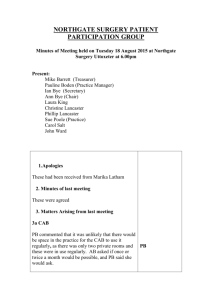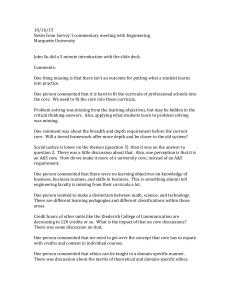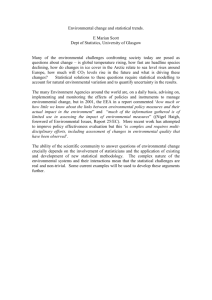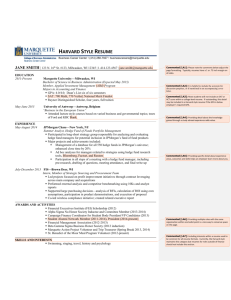Correct Format for Footnotes and Bibliography Europe’s Tragedy
advertisement
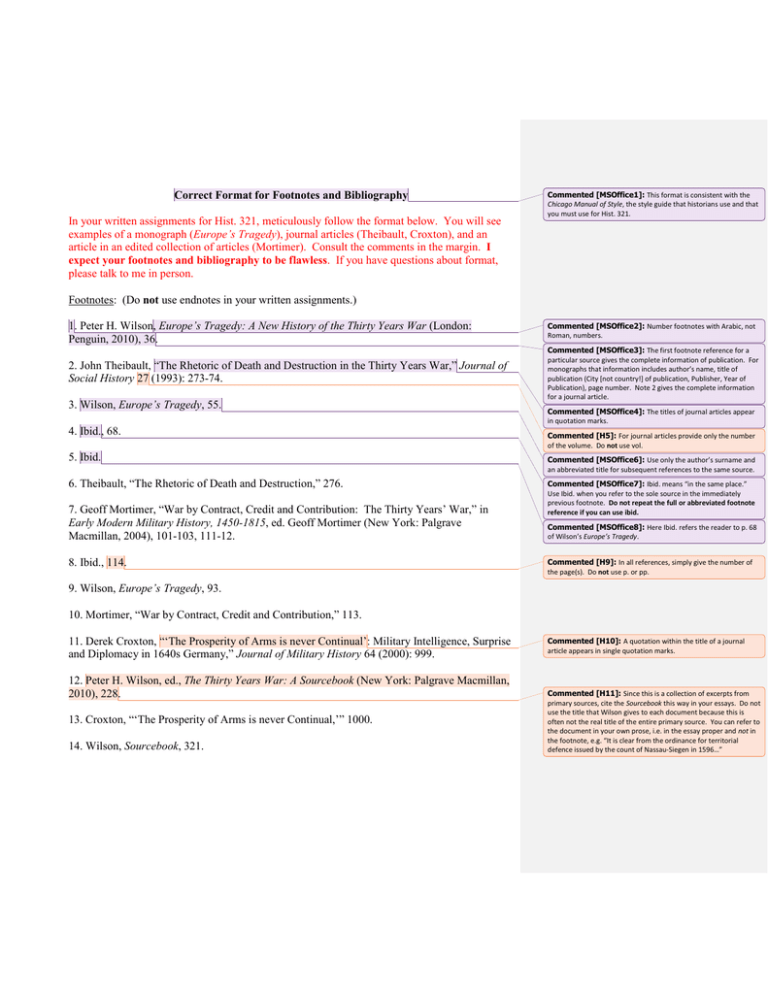
Correct Format for Footnotes and Bibliography In your written assignments for Hist. 321, meticulously follow the format below. You will see examples of a monograph (Europe’s Tragedy), journal articles (Theibault, Croxton), and an article in an edited collection of articles (Mortimer). Consult the comments in the margin. I expect your footnotes and bibliography to be flawless. If you have questions about format, please talk to me in person. Commented [MSOffice1]: This format is consistent with the Chicago Manual of Style, the style guide that historians use and that you must use for Hist. 321. Footnotes: (Do not use endnotes in your written assignments.) 1. Peter H. Wilson, Europe’s Tragedy: A New History of the Thirty Years War (London: Penguin, 2010), 36. Commented [MSOffice2]: Number footnotes with Arabic, not Roman, numbers. 2. John Theibault, “The Rhetoric of Death and Destruction in the Thirty Years War,” Journal of Social History 27 (1993): 273-74. Commented [MSOffice3]: The first footnote reference for a particular source gives the complete information of publication. For monographs that information includes author’s name, title of publication (City [not country!] of publication, Publisher, Year of Publication), page number. Note 2 gives the complete information for a journal article. 3. Wilson, Europe’s Tragedy, 55. 4. Ibid., 68. Commented [MSOffice4]: The titles of journal articles appear in quotation marks. Commented [H5]: For journal articles provide only the number of the volume. Do not use vol. 5. Ibid. Commented [MSOffice6]: Use only the author’s surname and an abbreviated title for subsequent references to the same source. 6. Theibault, “The Rhetoric of Death and Destruction,” 276. Commented [MSOffice7]: Ibid. means “in the same place.” Use Ibid. when you refer to the sole source in the immediately previous footnote. Do not repeat the full or abbreviated footnote reference if you can use ibid. 7. Geoff Mortimer, “War by Contract, Credit and Contribution: The Thirty Years’ War,” in Early Modern Military History, 1450-1815, ed. Geoff Mortimer (New York: Palgrave Macmillan, 2004), 101-103, 111-12. 8. Ibid., 114. Commented [MSOffice8]: Here Ibid. refers the reader to p. 68 of Wilson’s Europe’s Tragedy. Commented [H9]: In all references, simply give the number of the page(s). Do not use p. or pp. 9. Wilson, Europe’s Tragedy, 93. 10. Mortimer, “War by Contract, Credit and Contribution,” 113. 11. Derek Croxton, “‘The Prosperity of Arms is never Continual’: Military Intelligence, Surprise and Diplomacy in 1640s Germany,” Journal of Military History 64 (2000): 999. 12. Peter H. Wilson, ed., The Thirty Years War: A Sourcebook (New York: Palgrave Macmillan, 2010), 228. 13. Croxton, “‘The Prosperity of Arms is never Continual,’” 1000. 14. Wilson, Sourcebook, 321. Commented [H10]: A quotation within the title of a journal article appears in single quotation marks. Commented [H11]: Since this is a collection of excerpts from primary sources, cite the Sourcebook this way in your essays. Do not use the title that Wilson gives to each document because this is often not the real title of the entire primary source. You can refer to the document in your own prose, i.e. in the essay proper and not in the footnote, e.g. “It is clear from the ordinance for territorial defence issued by the count of Nassau-Siegen in 1596…” 15. Die Westfälischen Friedensverträge vom 24. Oktober 1648, Texte und Übersetzungen: Englische anonyme Übersetzung des IPM (1710), 2004, 12, accessed 4 March 2015, http://www.pax-westphalica.de/ipmipo/pdf/m_1710en-treatys.pdf. 16. Die Westfälischen Friedensverträge vom 24. Oktober 1648, Texte und Übersetzungen: Englische anonyme Übersetzung des IPO (1732), 2004, 17, accessed 4 March 2015, http://www.pax-westphalica.de/ipmipo/pdf/o_1732en-treatys.pdf 17. Englische anonyme Übersetzung des IPM, 22. Commented [HP12]: The title of the document. IPM refers to the Treaty of Münster. Commented [HP13]: The year that the document was published on the web. Commented [HP14]: The page number in the pdf file. Commented [HP15]: Give the (last) date when you viewed the document. Commented [HP16]: Abbreviated title of a subsequent citation of the Treaty of Münster with the page number in the pdf file. 18. Englische anonyme Übersetzung des IPO, 15. 19. Ibid., 23. See next page for Bibliography. Commented [HP17]: A reference to p. 23 of the pdf file of the English translation of the Treaty of Osnabrück. Bibliography: Primary Sources Acta Pacis Westphalicae: Supplementa electronica, 1. Die Westfälischen Friedensverträge vom 24. Oktober 1648, Texte und Übersetzungen: Englische anonyme Übersetzung des IPM (1710). 2004. http://www.pax-westphalica.de/ipmipo/pdf/m_1710en-treatys.pdf. Commented [MSOffice18]: Note that items in the bibliography are arranged by alphabetical order by the authors’ surnames. Divide your bibliography into two sections: Primary Sources and Secondary Sources. Commented [HP19]: Treat the series of documents as the author. Notice that in a bibliography you do not supply the access date. The only date that you give is the date of publication on the web. Acta Pacis Westphalicae: Supplementa electronica, 1. Die Westfälischen Friedensverträge vom 24. Oktober 1648, Texte und Übersetzungen: Englische anonyme Übersetzung des IPO (1713). 2004. http://www.pax-westphalica.de/ipmipo/pdf/o_1732en-treatys.pdf. Grimmelshausen, Hans Jakob Christoph von. Der abenteuerliche Simplicissimus. Edited by Alfred Kelletat. Munich: Winkler, 1956. Commented [H20]: In a bibliography, the author’s surname comes first. Every paragraph is set as a hanging indent. Wilson, Peter H, ed. The Thirty Years War: A Sourcebook. New York: Palgrave Macmillan, 2010. Secondary Sources Croxton, Derek. “‘The Prosperity of Arms is never Continual’: Military Intelligence, Surprise and Diplomacy in 1640s Germany.” Journal of Military History 64 (2000): 981-1003. Mortimer, Geoff. “War by Contract, Credit and Contribution: The Thirty Years’ War.” In Early Modern Military History, 1450-1815, edited by Geoff Mortimer, 101-117. New York: Palgrave Macmillan, 2004. Theibault, John. “The Rhetoric of Death and Destruction in the Thirty Years War.” Journal of Social History 27 (1993): 271-90. Wilson, Peter H. Europe’s Tragedy: A New History of the Thirty Years War. London: Penguin, 2010. Commented [H21]: Note the complete range of page numbers provided in the bibliographical reference to a journal article. Commented [H22]: Note the position of the complete range of page numbers of the article in an edited collection of articles.
